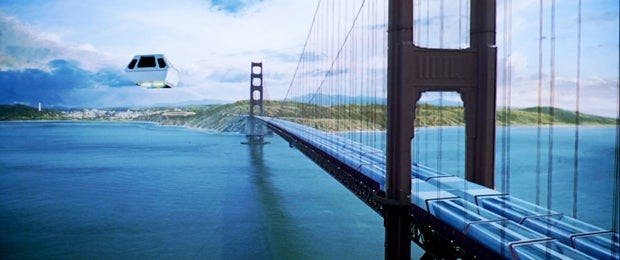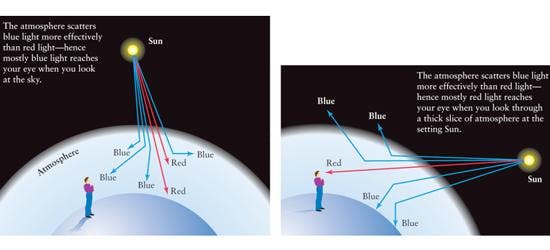
Why is the Sky Blue?
If you live in the northern hemisphere of our world, your summer is coming to an end. Hopefully everyone had some nice sunny days, with blue skies, maybe near a beautiful blue lake or ocean. And in the mornings and evenings you saw awesome orange, red or even purple sunrises and sunsets.
So why is the sky blue? Why are the sunrises and sunsets red?
Light from our Sun reaches the surface of our planet after passing through the atmosphere, which contains various gases as well as dust particles. Light particles, which are called photons, come in various wavelengths, of which our eyes can see dark red through dark blue (the colors of the rainbow). Light with shorter wavelengths and higher energy content (blue) gets scattered more by the atmosphere than light with longer wavelengths and less energy (red). So if you look up at the sky during the day, you see the scattered blue light.
During sunrise and sunset, the light from the sun travels through a thicker layer of atmosphere (see the geometry in the images below), so more of the blue light gets scattered out, leaving more of the red light. If in addition to the usual gases there is dust or ash in the atmosphere, say from a sand storm or a volcanic eruption, even more of the blue light scatters away. That’s why sunrises and sunsets are anywhere from orange to deep red, and particularly so, if there are lots of sand or ash particles in the air.

Figure 1: Why the sky is blue (left) and sunsets are red (right). Credit: Timothy F. Slater and Roger A. Freedman, Investigating Astronomy (2nd Edition), 2014, W.H. Freeman.
This is what we experience here on Earth, given the light we get from our Sun and the planetary atmospheric conditions. However, many planets we have encountered in Star Trek have different primary stars and different planetary environments.Some years ago I had an occasion to come up with a scenario for a planet which was supposed to have been the home of an ancient long dead civilization.The variables to consider are:-- the temperature and hence the color of the primary star-- the planet must support liquid water, i.e. must be in the habitable zone.-- the planet must have about Earth-normal gravity (for the sake of the actors and the budget)The consequences of these choices can vary.
The star is about a K2V, which emits more longer wavelengths than our Sun. It is still in the stable phase of its evolution (i.e. be a main sequence star), otherwise things would get rather nasty environment-wise. Since its main energy output is in longer wavelengths, it is cooler and more orange in color. And since it is still stable, it is a tad smaller and less massive than our Sun. It is also a lot older than our Sun, about twice the age (i.e. about 9 billion years old). Our Sun is a G2V (main sequence dwarf with a peak wavelength of 550 nm), which is in the middle of the yellow range).
Since the planet has to have liquid water in order for life as we know it to evolve, its surface temperature has to be above 273K (or 0 C, or 32F). Given that the star is cooler than the Sun, we have two variables to play with: either put the planet closer to the star, which means you have a somewhat larger sun in the sky, or introduce a significant greenhouse effect to warm the surface of the planet. This latter choice would mean that the sky is very hazy, with thick clouds, and the sun would be barely visible through this soup. There would be no blue skies, and much redder sunsets.
The Earth has a natural greenhouse effect, about 36 degrees worth. If it was not for this side-effect of life, the temperature on Earth would be below the freezing point of water. The temperature is kept up by the effects of life, i.e. the presence of CO2, methane, and water vapor. As an example, Venus has an extreme greenhouse effect (800 degrees worth), and atmosphere of mostly CO2, as well as a surface pressure of 90 atmospheres.
And here's the next problem: if we presume that our humanoid characters walk the surface of the planet without wearing full containment suits, the pressure has to be low enough for them to exist without. So the greenhouse effect cannot be too large. And then there’s this problem… even a moderate greenhouse effect has to be maintained, i.e. there needs to be a source for CO2, methane and water vapor. If life on Earth stopped today, our greenhouse effect would be gone within a decade or two, and Earth would be a frozen planet. One way to accomplish this could be a lush and very soggy jungle world, in order to provide the output of the needed gases. If we want an ancient looking world, most of it being land, we could have that jungle on one side, and drier areas on the other side where the ruins of the civilization are found. Volcanoes are also a good source for these gases, so we could have a few active ones around.
So the scenario I suggested for this ancient world was one jungle-continent on the far side, a few active volcanoes, a hazy rich cloud cover through which we see an orange sun, looking about the size of ours. When approaching from space the star will look dark yellow to light orange, but when looking through these clouds a lot of the blue light will be scattered, so the star will look very orange during the day and very deep red at the end of sunset. The air will be heavy; there will be more CO2 in it, so any human characters might find it challenging. And if there's more methane, the air will have a decidedly bad odor to it. The pressure will also be slightly higher, so ears will pop when disembarking from a landed vehicle, unless the pressure is equalized inside the vehicle before leaving it. Depending on what we want the temperature to be, we can move the planet a bit closer to the star and/or increase the greenhouse effect by a bit. If we need a clearer sky, we'll have to move the planet quite a bit close to the star.
As you can see, inventing a believable scenario on an alien planet means playing with a lot of variables. Hopefully by now you can envision beautiful dark red sunsets on Vulcan (desert planet, lots of sand particles in the air), and very bright days on Andor (a moon to a gas giant around Procyon, an F5V star). Allowing for moons to be the inhabited worlds brings a host of new variables into play. The scenarios are endless.
Recently the SETI Institute issued a press release about new methods allowing us to find tiny particles in exoplanet atmospheres. Their technique involves looking for the blue light scattered by particles in their atmospheres ten times smaller than the width of a human hair. New technologies allow us to do this for these very far away systems. This might make it possible to figure out what planetary skies in other solar systems would look like. Who knows, we might find worlds with quite similar or very different notions of what a nice summer day might be.

Figure 2: Potentially habitable exoplanet Kepler 62f (artist concept, Credit: NASA Ames/JPL-Caltech).
Here are a few links for you if you’d like to know more about this topic.SETI Institute Press Release (How Can We Find Tiny Particles in Exoplanet Atmospheres?):http://www.seti.org/seti-institute/press-release/how-can-we-find-tiny-particles-exoplanet-atmospheresThe SETI Institute:http://www.seti.org/Memory Alpha:http://en.memory-alpha.orgInge Heyer:www.ingeheyer.com
____________
Inge Heyer is an avid Star Trek fan and frequent convention guest. After earning a BA in physics and astronomy, Heyer obtained a master's degree in astronomy at the University of Hawaii. As a senior data analyst at the Space Telescope Science Institute in Baltimore, she worked on images received from the the Hubble Space Telescope's Wide-Field and Planetary Camera 2. Following this she led the outreach education efforts for the Joint Astronomy Centre in Hawaii. More recently, she has obtained her doctorate in Science Education from the University of Wyoming, and is now a visiting assistant professor in astronomy and physics at Loyola University Maryland.

